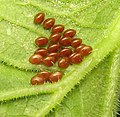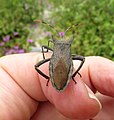Coreidae
| Coreidae Temporal range:
| |
|---|---|

| |
| Anoplocnemis curvipeswith typical enlarged hind femora | |
| Scientific classification | |
| Domain: | Eukaryota |
| Kingdom: | Animalia |
| Phylum: | Arthropoda |
| Class: | Insecta |
| Order: | Hemiptera |
| Suborder: | Heteroptera |
| Superfamily: | Coreoidea |
| Family: | Coreidae Leach,1815 |
| Subfamilies | |
| |
Coreidaeis a largefamilyof predominantly sap-sucking insects in theHemipteransuborderHeteroptera.[1]The name "Coreidae" derives from the genusCoreus,which derives from theAncient Greekκόρις(kóris) meaningbedbug.[2]
As a family, the Coreidae arecosmopolitan,but most of the species aretropicalorsubtropical.
Common names and significance
[edit]The common names of the Coreidae vary regionally. Leaf-footed bug refers to leaf-like expansions on thelegsof some species, generally on the hind tibiae. In North America, the pest status of species such asAnasa tristisonsquash plantsand othercucurbitsgave rise to the name squash bugs.[3][4]The Coreidae are called twig-wilters or tip-wilters in parts of Africa and Australia because many species feed on young twigs, injecting enzymes thatmaceratethe tissues of the growing tips and cause them to wilt abruptly.[5][6]
Morphology and appearance
[edit]The Coreidae commonly are oval-shaped, with antennae composed of four segments, numerous veins in the membrane of the fore wings, and externally visible repugnatorial stink glands. They vary in size from 7 to 45 mm long, which implies that the family includes some of the biggest species ofHeteroptera.The body shape is quite variable; some species are broadly oval, others are elongated with parallel sides, and a few are slender. Many species with the "leaf-footed" tibiae are very slender with conspicuous expansions of the hind tibiae, but some robust species also have decided expansions. Some species are covered with spines and tubercles.[7]As an example of these, thetribePhyllomorphini Mulsant & Rey, 1870, are strikinglyaberrant,with thin legs, spiny bristles, andlaciniateoutlines and adornments.
Many of the morerobustspecies have grossly enlarged, thickened, and bowed hindfemoraarmed with spikes on the inner edge, and with hindtibiaeto match, though the enlargement of the tibiae is less exaggerated.[1][3]
In thenymphs,the openings of the tworepugnatorialstink glands of the Coreidae are visible as two projections or spots on themedialline of the dorsal surface of the abdomen, one at the anterior and one at the posterior edge of the fifth abdominaltergiteabove the glands inside. During the finalecdysis,the anatomy is rearranged and the glands end up in themetathorax,opening laterally throughostiolesbetween themesothoracicandmetathoracicpleura.[8]
Biology and habits
[edit]The Coreidae generally feed on the sap of plants. Some species reportedly are actively carnivorous,[9]but material evidence is lacking, and in the field, some are easy to confuse with some species of theReduviidae,so doubt has been cast on the veracity of the claims.[10]
Some Coreidae, such asPhyllomorpha laciniata,exhibit parental care by carrying their eggs. This behaviour significantly improves the eggs' chances of avoiding the attacks ofparasitoids.[11]
Taxonomy and systematics
[edit]The Coreidae are placed in the orderHemipteraand closely related to the familiesAlydidae,Hyocephalidae,Rhopalidae,andStenocephalidae.Together, these five families form the superfamilyCoreoidea.The family is large, with more than 1,900 species in over 270 genera.[7]
Most taxonomists dealing with the Coreidae divide the family into three or sometimes foursubfamilies.Numeroustribesof the Coreinae have previously been proposed for elevation to subfamily rank, for example, theAgriopocorini,Colpurini,Hydarini,Phyllomorphini,andProcamptini,but the only one of these changes that at least a significant minority of researchers currently accept is the elevation of the Agriopocorinae, and recent reviews tend to treat them as a tribe again, recognizing only the three subfamilies known by 1867. Another difficulty is that the genusEubulehas not yet been placed.
The family has been demonstrated to be non-monophyletic,asHydarinaeandPseudophloeinaeare more closely related to Alydidae than to other coreids.[12]
Accordingly, the subfamilies are as follows, together with illustrative genera of each:
CoreinaeLeach, 1815
- AcanthocephalaLaporte, 1833
- AcanthocerusPalisot, 1818
- AlthosKirkaldy, 1904
- AmblyomiaStål, 1870
- AmblypeltaStål, 1873
- AnasaAmyot & Serville, 1843
- CanungrantmictisBrailovsky, 2002
- CatorhinthaStål, 1859
- ChariesterusLaporte, 1833
- ChelinideaUhler, 1863
- ChondroceraLaporte, 1832
- CimolusStål, 1862
- CoreusLeach, 1815
- DaladerAmyot & Serville, 1843
- DallacorisOsuna, 1981
- ElasmopodaStål, 1873
- EuthochthaMayr, 1865
- FicanaStål, 1862
- HelcomeriaStål, 1873
- HolhymeniaLepeletier & Serville, 1825
- HypselonotusHahn, 1833
- LeptoglossusGuérin-Méneville, 1831–conifer seed bugs
- MaduraStål, 1860
- MamuriusStål, 1862
- MenenotusLaporte, 1832
- MictisLeach, 1814
- MozenaAmyot & Serville, 1843
- NamacusAmyot & Serville, 1843
- NarniaStål, 1862
- NisoscolopocerusBarber, 1928
- PephricusAmyot & Serville, 1843
- PhthiaStål, 1862
- PhyllomorphaLaporte 1833
- PlectropodaBergroth, 1894
- PiezogasterAmyot & Serville, 1843
- SagotylusMayr, 1865
- SaviusStål, 1862
- ScolopocerusUhler, 1875
- SephinaAmyot & Serville, 1843
- SetheniraSpinola, 1837
- SpartoceraLaporte, 1833
- ThasusStål, 1865
- ZiccaAmyot & Serville, 1843
|
AgriopocorinaeMiller, 1953(often included in Coreinae)
|
MeropachyinaeStål, 1867
|
PseudophloeinaeStål, 1867
|
Gallery
[edit]-
Feeding "twig-wilter" nymph
-
Anasa tristis(squash bug) eggs
-
Pephricussp., of the tribe Phyllomorphini
-
A "leaf-footed" coreid (Anisoscelis flavolineata) with typical expanded hind legs
-
Typical pattern of wing venation
-
Piezogastersp. mating
-
Laying eggs
-
Twoleaf-footed bugsinteract.
-
Insects live in a world of motion. Thisleaf-footed bugclimbs wind blown grass and flies off.
References
[edit]- ^abGordh G, Headrick, DH (2000).A Dictionary of Entomology.CABI Publishing.
- ^"Corèidi in Vocabolario - Treccani".
- ^abBaranowski, R M (1986).Coreidae of Florida (Hemiptera: Heteroptera).Florida Department of Agriculture and Consumer Services.
- ^Hawkins, R D (2003).Shieldbugs of Surrey.Surrey Wildlife Trust.
- ^Alan Weaving; Mike Picker; Griffiths, Charles Llewellyn (2003).Field Guide to Insects of South Africa.New Holland Publishers, Ltd.ISBN1-86872-713-0.
- ^Jorge E. Peña; Jennifer L. Sharp; M. Wysoki (2002).Tropical Fruit Pests and Pollinators: Biology, Economic Importance, Natural Enemies, and Control.CABI. pp. 237–.ISBN978-0-85199-976-0.
- ^abSchuh RT, Slater, JA (1995).True Bugs of the World (Hemiptera: Heteroptera). Classification and Natural History.Cornell University Press.
- ^Beard, Raimon L. The Biology of Anasa tristis DeGeer. Bulletin 440. Connecticut Agricultural Experiment Station, New Haven 1940[1]
- ^Comstock, J. H. An Introduction to Entomology, Comstock Publishing. 1949. May be downloaded from:[2]
- ^University of Kentucky Entomology/Kentucky Critter Files/Kentucky Insects/True Bugs/Leaf-footed Bugs[3]
- ^Gomendio, M; García González, F; Reguera, P; Rivero, A (2008)."Male egg carrying in Phyllomorpha laciniata is favoured by natural not sexual selection".Animal Behaviour.75(3): 763–770.doi:10.1016/j.anbehav.2006.12.029.S2CID14633463.
- ^Forthman, Michael; Miller, Christine W.; Kimball, Rebecca T. (2019)."Phylogenomic analysis suggests Coreidae and Alydidae (Hemiptera: Heteroptera) are not monophyletic".Zoologica Scripta.48(4): 520–534.doi:10.1111/zsc.12353.ISSN1463-6409.
External links
[edit]- Coreidae of Britain
- Coreidae of Florida
- Comparative description of the immature stages of two very similar leaf footed bugs,Holymenia clavigera(Herbst) andAnisoscelis foliacea marginella(Dallas) (Hemiptera, Coreidae, Anisoscelini)
- Coreidae (Heteroptera: Pentatomomorpha)Archived2010-04-26 at theWayback Machine
- Chelinidea vittiger aequoris,a cactus bug,
- Euthochtha galeator
- Leptoscelis tricolor,heliconia bug
- Leptoglossus phyllopus
- Spartocera batatas,giant sweetpotato bug








